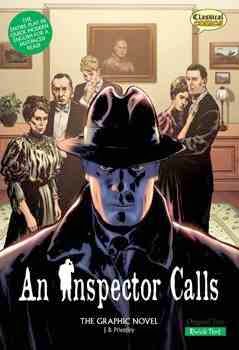Someone Called, Did You Take A Message?
So I am having a reading success story this week, I read the graphic novel version of An Inspector Calls [quick text edition] for work.
It was never something I studied in school so I was going into it blind.
On first glance I like the style of this series. You also get a biography of JB Priestley at the end and a piece on page creation that gives you great insight into how a graphic novel is produced. There's a small piece of comparison between this quick text version and the original text version. At the beginning of the book you have the character list that you would find at the beginning of a normal play script, but with the addition of sketches. The colouring of the illustrations is very earthy, browns, reds, purples, greens. While I like the illustration, some of the faces seem a little obscured by the thick shading and dark colours.
You can sense family tension right from the beginning of the book. Arthur Birling is very power crazed and you can tell that he thinks he's very important. When the inspector calls there is an obvious power struggle between the two. They battle is out, and when Goole says he's not there just for him there is a very well placed "silent" panel that portrays the scene with great accuracy.
Although there are differences between the characters visually it is difficult to keep track, I'm not sure whether that's because I'm out of practice reading graphic novels or issues with the illustrations.
You get to see the relationship between Shelia and Gerald strain when talking about the dead girl, the interaction between them works well on the page, with an especially good image of Shelia's face looking at him with contempt.
You can see where the story is leading and it gets a little bit frustrating that no one will say it out loud. You can see some vaguely un-policeman like behaviour but not knowing what is coming next I didn't have a clue what I was seeing. There is clearly an ulterior motive, but what?
It's interesting to see how the older generation manage to pass the buck on their responsibility, but the younger actually take it to heart and seem ashamed. Both Mrs and Mr Birling seem determined to blame their son. Once they've realised the inspector is a fake it "makes all the difference", but how? They are still guilty of their behaviour. Gerald says about the possibility of it being a hoax, it isn't a hoax if all those events are true. How could someone have come up with that plan is it wasn't all true.
All along we've been finding out that the future is what we make it, our lives are so entwined that every action has consequences. No matter how small, you can never know what it might lead to.
The ending left me annoyed. Had the "inspector" found out about Eva's tale and orchestrated her death? Had he put it all together from different girls and killed one of them himself to bring down the family? Have I just watched too much CSI?
Personally, while I like the story I think I would have benefited from reading the original text over quick text. As an aide to classroom learning though I think this would be a great tool. Even reading online summaries I got the same impression of the story as that of this adaptation. There weren't bits of the text that weren't clear, although I did have issues with the illustrations I'm more than comfortable putting that down to my lack of concentration. As an introduction before studying the text or used to help struggling students, it would be very useful.




Comments
Post a Comment